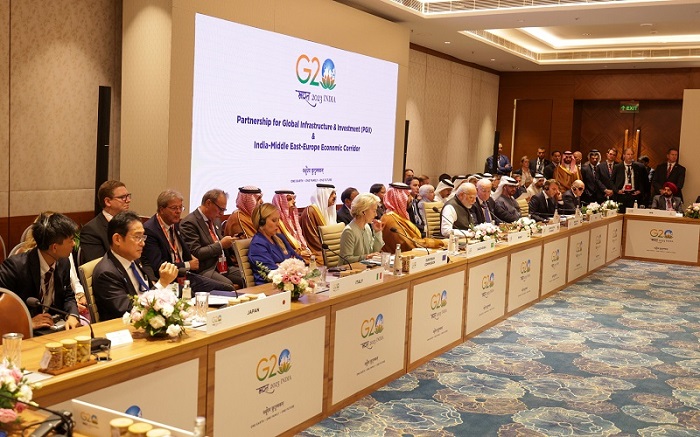New Delhi: With an aim to dominate global supply chain, the India-Middle East-Europe Corridor (IMEC) was launched on the sidelines of the G20 summit in New Delhi in September last year.
The IMEC, which was hailed as a "real big deal" by the US President Joe Biden, is a key pillar of the United States' Indo-Pacific and Middle East strategies.
According to a Politico report, the West hopes this economic corridor, which has been described as the United States' alternative to China's Belt and Road Initiative (BRI), can limit Beijing's rising geopolitical interference.
The Indian government in March approved the Inter-Governmental Framework Agreement (IGFA) between India and the United Arab Emirates (UAE) on cooperation for the empowerment and operation of the proposed ship-to-rail transit network, IMEC.
Saudi Arabia has already committed to investing $20 billion (€18.4 billion) in the project, much of it on the rail network, according to moneycontrol.com.
Experts believe that the proposed economic corridor will happen and it will achieve its goals, even amid the ongoing war between Israel and Hamas in the Gaza strip, and the rising geopolitical tensions between Israel and Iran.
The proposed economic corridor has been designed with an aim to connect goods, energy and data from India to Europe via the Middle East through rail and sea networks, cables and pipelines, and one of the key parts of the project is expected to be a rail link that would connect the UAE and Saudi Arabia with Israel via Jordan.
According to officials involved with the project, the proposed corridor will consist of two distinct sections -- the East corridor connecting India to West Asia and Middle East and the Northern corridor connecting West Asia and Middle East to Europe.
The rail network will enhance cross-border ship-to-rail transit networks, providing a reliable and cost-effective solution for goods and services transhipment between South East Asia, India, and West Asia, Middle East and Europe, the moneycontrol.com report said.
The United States and the European Union (EU), with the proposed IMEC, aim to draw India closer.
The proposed economic corridor would provide a boost to India’s strategy to escape encirclement by Beijing and become a leader among developing countries, while the UAE and Saudi Arabia embrace IMEC as part of their push to become an economic bridge between East and West, according to pan-European think tank the European Council on Foreign Relations.
A report by the European Council on Foreign Relations said that for the corridor to fulfil the project's potential, the participants will need to coalesce around implementation plans that can reconcile these different goals, and they will also need to overcome internal and external obstacles along each leg of the corridor.
It added that Europeans should view IMEC as providing a long-term addition to current trade routes, and should also press for the corridor to expand into a network, promote trade liberalisation with India, and support all the participants as they transition to renewable energy.
When the project is successful, IMEC could enhance Europe’s economic resilience and increase its options for trade diversification, according to the think tank.
The US is pushing for IMEC as a counter to the Chinese Belt Road Initiative (BRI), which is a result of China's shift to a ‘consumption-led growth’ approach and includes almost 150 countries, 60 percent of the world's population, and 40 percent of the global GDP, including advanced economies such as Greece and Singapore.
The geopolitical tensions are rising in the Middle East after Hamas carried out an attack on Israel on October 7 last year and Israel retaliated relentlessly resulting in the ongoing war in Gaza.
Meanwhile, attacks on vessels in the Red Sea by Iranian-backed Houthi rebels and rising conflicts between Israel and Iran also have triggered tensions in the region.
However, experts still believe this grand US-led connectivity project to link the EU and India via the Gulf can still happen – and it can serve the geopolitical goals of all its participants.
